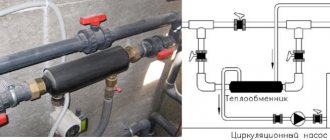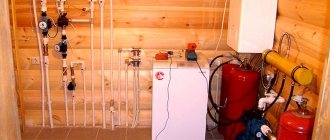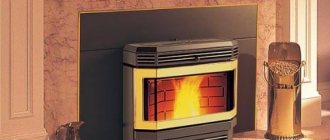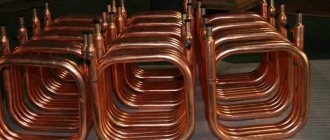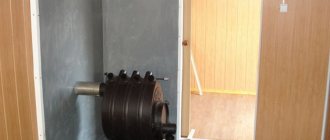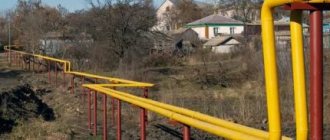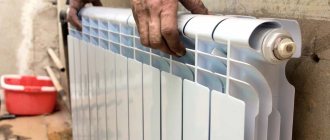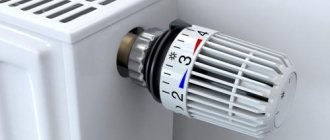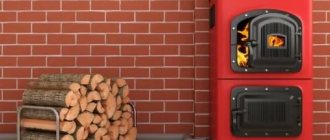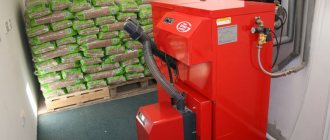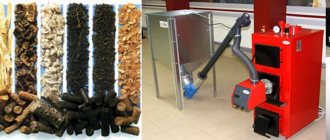Introduction
I was prompted to write this article by a statement from a friend: “Whatever they can come up with to make money from ordinary people. In fact, pellets are beneficial to the manufacturer, they bring money, and ordinary people are neither cold nor hot from them.” This expression really hurt me and I answered him very beautifully and delicately. Want to know how? Read the article further!
The confrontation between pellets, gas and firewood is constantly gaining momentum. And if everything is clear with gas, when will the areas be gasified? In areas with autonomous heating, many local residents are counting ten times whether to install a pellet boiler, or continue to heat with wood?
Let's put all the “Is” in this dispute.
Dacha.news
06.02.2016
Heating
We calculated the cost of obtaining 1 kWh of heat from various types of fuel, as well as the costs for the entire heating season, plus the payback period of heating systems.
It is generally accepted that the most profitable heating option is main gas. But not everyone can say exactly how quickly its connection will pay for itself, even if a gas pipe is already laid along the border of your site. Therefore, the question “what is cheaper to heat a house” will be very relevant. To answer this, we have prepared two tables and a chart. The first table contains information on the cost of obtaining 1 kWh of heat from various types of fuel at prices at the beginning of 2021. The diagram shows fuel costs for one heating season. And in the second table - the payback period of heating systems in comparison with an electric boiler.
Table of the cost of obtaining thermal energy for heating from various types of fuel
| Type of fuel | Price per unit, rub. | Cost of heat received per 1 kWh, rub. | Typical efficiency of boilers (furnaces), % | Cost of heat received per 1 kWh taking into account efficiency, rub. |
| Eco-pea coal, kg. | 3 | 0,39 | 0,8 | 0,48 |
| Main gas, cubic meters | 5,04 | 0,54 | 0,9 | 0,60 |
| Dry pine firewood (20%), kg. | 3,9 | 0,99 | 0,7 | 1,41 |
| Air-to-water heat pump, kW.** | 1,1 | 1,10 | 1,10 | |
| Pellets, kg. | 6 | 1,26 | 0,8 | 1,57 |
| Firewood with natural humidity, coniferous (40%), kg.* | 3 | 1,33 | 0,7 | 1,90 |
| Liquefied gas, l. | 15,3 | 2,71 | 0,9 | 3,01 |
| Diesel fuel, l. | 29 | 2,86 | 0,85 | 3,37 |
| Electricity (day/night)*** | 4,11 | 4,11 | 4,11 |
* - taking into account the density of stacked chopped firewood and the density of the wood itself ** - taking into account the efficiency at average temperatures in the region of -5 ° C, which corresponds to winter near Moscow *** - the average value of tariffs for Moscow Region is taken in proportions of 2/1.
The data in the table is sorted by the cost of the heat produced when burning each type of fuel , converted into kWh. We deliberately did not sort the list based on boiler efficiency, since there may be variations here. Although the bulk of high-quality boilers for various fuels have an efficiency of 80%. We will also leave aside issues of ease of use of a particular type of fuel. Of course, the most problem-free options here will be electricity, a heat pump, as well as main gas, albeit to a lesser extent. In other cases there will be more trouble.
Next, we will calculate the cost of the heating season for the Moscow Region based on a house with an area of 100 m2 insulated according to SNiP. Conventionally, we will assume that it is necessary to actively heat from approximately November to March (150 days a year). Moreover, with an average temperature difference of 25 degrees (we take the average temperature of all five months as -4°C), the total heat loss will be approximately 2.3 kW. Those. You need to spend 55.2 kWh per day to heat such a house. For a season – ~8280 kWh.
Costs per heating season for different types of fuel for an insulated house of 100 m2
The most profitable types of fuel are coal and gas. The most expensive is electricity.
Now let's calculate the payback periods of heating systems for different types of fuel . Let's assume that the house has water heating with an electric boiler with a capacity of 9 kW (15 thousand rubles). Let's take this as a basic option. To switch to main gas, you need to replace the boiler (15 thousand rubles), install a chimney (30 thousand rubles) and connect to the main line (from 50 to 400 thousand rubles, for calculations we used 200 thousand). To switch to coal, firewood or pellets, you also need to install a chimney and replace the boiler with an appropriate one (40 thousand rubles for a regular one and ~80 thousand for a boiler with automatic feed), plus prepare a storage room. For liquefied gas, among other things, you will need a gas tank with an installation (190 thousand rubles). And for a heat pump – the system itself with installation (~350 thousand rubles). In this case, we will assume that the owner then carries out the removal of ash and maintenance of the systems independently.
Payback period of various heating systems in comparison with an electric boiler
| Type of fuel | payback, years |
| Eco-pea coal | 1,8 |
| Dry pine firewood (20%) | 2,5 |
| Pellets | 2,6 |
| Firewood with natural humidity, coniferous (40%) | 3 |
| Pellets (with automatic feeding) | 4,5 |
| Main gas | 6,9 |
| Diesel fuel | 9,7 |
| Air-to-water heat pump | 13,4 |
| Liquefied gas | 21 |
| Electricity (day/night) | 0 |
Everyone should draw conclusions from this table themselves in accordance with their needs and capabilities. Let’s just make a reservation that for houses with a larger area than we took into account, heating with electricity is not applicable, since electric boilers with a power of 10 kW or more already require connection to a three-phase 380 V network. Also, payback calculations will be slightly different for houses with an area of more than 200 m2.
Important note! All calculations in the article are given without taking into account ventilation losses, which for one reason or another is usually absent in small country houses. If we follow SNiP in this matter, when the air in the room of the configuration in question must be renewed approximately once an hour, then heating costs should approximately triple! But in practice, ventilation, if it is not forgotten, is provided by supply valves and vents, which can ultimately increase the costs shown in the diagram by 1.5 times. Accordingly, this will lead to a decrease in the payback period in the table.
You may also be interested in: - What is the difference between the best firewood and the bad - Buleryan: the design of the stove or where does the efficiency of 80% instead of 30% come from?
boilersfuel
Article rating: ( 23 votes, average: 4.00 out of 5)
Aesthetic side
- Automatic fuel supply, automatic temperature control of the coolant or in the room - all this can be provided when heating with pellets. Heating with wood needs to be constantly monitored, but there is also a nuance here in the form of modern long-burning boilers Link, which have a loading hopper of logs, automatic long-term burning while maintaining the desired temperature;
- Smaller areas for more energy; one ton of pellets replaces about 3.5 cubic meters of firewood. And if pellets are stored in specialized bunkers, then this is generally super convenient;
Pos 1. - unloading from the vehicle using a fan. Pos. 2 supply from the warehouse to the boiler. Pos. 3 - pellet boiler. Pos. 4 - boiler with double circuit.
- But the firewood storage areas themselves are much less finicky. If pellets require a covered, dry room, which may not be heated, then chocks and logs in many villages are still stored outside under the snow in winter. Light the stove with dry wood chips and throw in the raw logs;
- When using firewood, the apartment gets colder. To haul firewood for a day into a house with an area of 50 square meters and at an outside temperature of 30 degrees, you will need to bring in logs at least 2-3 times in the morning and the same amount in the evening, while you constantly need to sweep up debris from the logs near the stove. In total, you will go out 6 times and sweep twice :-). With pellet heating, it will be enough to bring one large bucket of pellets. If you use specialized bunkers, then everything will work automatically. You only need to refuel the bunker once a quarter and that’s it;
- After purchase, wood pellets are immediately ready for heating, but in most cases the logs need to be dried, and sometimes sawn and split;
- The availability of these types of fuel depends on this parameter - whether the owner will use this type of fuel. There is no clear answer to this parameter. There are areas where firewood is “lying under your feet,” so you go into the forest, dump a piece of wood, drag it home, and you’re done. This is roughly how we lived in the village. New Zarya. And there are areas where firewood has not been seen and from time immemorial they have used other types of fuel. One can say about pellets - the logistics of manufacturers works in such a way that in all large cities they are available, but in some village they most likely will not be.
- Scientists have proven that pellets, when burned, produce less carbon dioxide than firewood. This is due to their lower humidity than firewood. The fact is that logs dried in a woodshed have a moisture content of 20%, and pellets 8%. Therefore, when burning granules, less moisture needs to be evaporated, resulting in a higher combustion temperature. Due to the increased temperature, the fuel burns better and less carbon dioxide and ash are formed.
From all of the above, we can conclude that pellets are more convenient for heating. No one will argue with this, not even my friend, but firewood is more practical and cheaper. Let's consider our question further.
Pellets
Fuel pellets are biologically pure fuel produced from peat and wood waste. They look like small oblong granules. In Europe they are used in boiler rooms or for heating country houses. This is an environmentally friendly fuel with a low percentage of harmful emissions into the atmosphere. Residential private houses, boiler houses for housing and communal services, etc. are heated with pellets. Fuel pellets are also used as cat litter.
How are pellets classified?
Pellets with a low bark content of up to 0.5% have the lowest percentage of ash content and are the most environmentally friendly. They heat living quarters. The percentage of bark in industrial pellets is up to 10% of the total volume of processed wood. Such material is used as fuel in production facilities or boiler rooms.
In Europe, the use of pellets as fuel is widespread and quality standards have been created for the production of pellets. There are no standards in Russia, so when exporting you have to pay attention to the percentage of bark content.
Financial side
Let's look at the financial side:
Of course, everyone understands that it is more convenient to heat with pellets, but the cost of converting from firewood to pellets worries every owner. And this is one of the important points. Many owners are afraid that they will have to demolish the wood-burning stove, but in some houses this is half the living space!
- In fact, today everything is much simpler; it is enough to replace the grate and attach a pellet burner to the old stove.
- The next point that worries the owner is - is it cheaper to heat with pellets or logs? The arithmetic here is simple, one ton of pellets replaces 3.5 cubic meters of firewood. If pellets in a store cost 6,000 rubles per ton, then a cubic meter of split firewood costs around 1.5 – 2 thousand rubles. According to all calculations, this is approximately the same. The difference can only be at a specific place, where prices may be slightly different from what I indicated. Therefore, here everyone can calculate everything themselves.
- If we take the production of heating from scratch, then an automatic pellet stove will cost 5-8 thousand rubles more than a new wood-burning boiler.
What is better: European firewood or pellets?
- Even high-quality European firewood contains 8-10% moisture. When moisture leaves the wood, about 20% of the efficiency of the heating device is lost. The small size of the pellets prevents moisture from accumulating. If you heat your house with pellets, they will last for a longer time. Europeans mainly use pellets to heat their homes, and this is not so much about environmental friendliness as it is about saving.
- Solid fuels are always sold by weight. When buying regular firewood or firewood in briquettes, where moisture may be present, we overpay.
- Pellets are environmentally friendly and safe. Virtually no odor during combustion. You will only feel a subtle aroma of wood.
- There are practically no foreign impurities in pellets
- Pellets have a higher energy concentration than European firewood. They burn longer.
- To heat with pellets, pellet boilers must be installed in the house. They are less bulky than conventional stoves or fireplaces for European wood. You can clean a pellet boiler once a season, which again saves time and effort.
- Pellets are suitable for automatic stoves. They are very convenient in servicing an entire plant. They do not clog the equipment.
- Low ash content. The residual ash can then be used as fertilizer.
- Low cost of pellets compared to other types of fuel.
My services
If you are going to make your own production of fuel pellets or are going to install heating using pellets, then you will simply need high-quality information on how to do it correctly and better. Why do I say this because I know how often things are organized poorly. So, in order not to get burned, I offer consulting services. You can contact SUPPORT and get quality information.
conclusions
I have given information that needs to be processed. Gave advantages of pellets over firewood and vice versa. For each case you need to select your own optimal option. For example, I would not install a pellet boiler in a village where everything is heated with wood, which is available for practically nothing. Just like in a large cottage in the suburbs I would not heat it with wood, since it would be much more convenient for me to heat a large area with pellets.
No one will decide for you what exactly you need. So go ahead and good luck to you. Oh, and by the way, I forgot about the answer to my friend. And I answered my friend like this: “If it weren’t beneficial for the consumer, then everyone would have gone bankrupt long ago, try to get you from a Mercedes to a Muscovite and will you get in?”
Good luck and see you again, Andrey Noak was with you!
